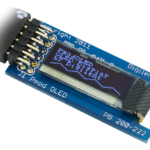Nearly all electronic devices used today have some type of display integrated into them. Displays can be simple and provide very basic information, like a simple screen on a calculator. They also can be larger and more complex components of a system, allowing you to experience a device’s full graphical interface.
Usually the important information expressed about a display is its total screen size, pixel density, contrast ratio, and so on, with little attention being paid to the underlying technology of the display. Today’s blog post aims to address this topic in depth.
I’ll be tackling the concepts behind organic light emitting diode (OLED) displays, the technology found in the PmodOLED and PmodOLEDrgb.
Behold, a diagram of a traditional LED.

A OLED display functions on the same basic concept as a normal LED. With a normal LED, you apply a voltage to either side of the diode (the anode and cathode of the LED). Once the voltage across the diode has reached or exceeded a certain threshold, current then begins to conduct across the diode and consequently the diode produces light. This principle of operation is exactly the same for an OLED display, however the material between the two sides of the diode is an organic molecule instead of a solid silicon material. The organic material, which can be applied in multiple layers, is sandwiched between two conducting surfaces (its anode and cathode), allowing for a very thin display surface.

There are a couple of disadvantages that are inherent with OLED displays compared to a liquid crystal display (LCD). The total number of operating hours you can get out of current technology is much lower than that of LCD screens. Additionally, color balance is difficult to maintain over the life of the screen, since the material used to produce blue light degrades much faster than the green or red in the display.
OLED display technology does however provide a number of benefits over traditional LCD. The first benefit is evident in the name itself. The fact that an OLED display is a display of light emitting diodes means that it does not require any kind of backlighting in order to be visible, where LCD technology requires the use of a backlight. This also allows for a second benefit, which is display thickness. Since the entirety of the display is within the confines of the anode layer and the cathode layer, the OLED displays can be extremely thin. Further benefits include things like lower overall power consumption (in most cases), better image quality in terms of brightness, contrast, and viewing angle, as well as increased durability and temperature tolerance.
The ability to create small displays that do not require an independent backlight allows this technology to be well suited for small form factor applications, such as the PmodOLED and PmodOLEDrgb.


As I mentioned in the beginning, there is a lot of functionality that can be added to a device through the addition of a display. These two Pmods provide an easy means for you to add that extra level of interaction with a project. Whether it is something simple like displaying sensor data or displaying images (as part of a microcontroller sketch) there are endless possibilities unlocked by adding an OLED display to your project!


A OLED display functions on the same basic concept as a normal LED.thanks
No there is some difference like OLEDs can turn on or off each pixel independently, which means they can provide better and more natural colors than LCD screens.
Hi thanks for sharing this information, old display is better for many kind of events in this display in more experience and make sense.